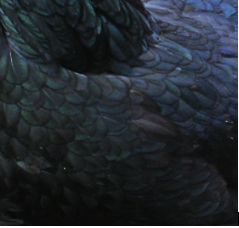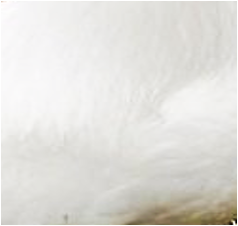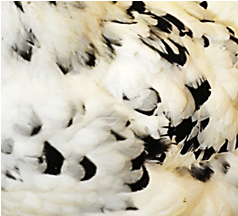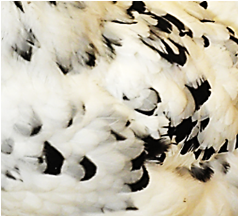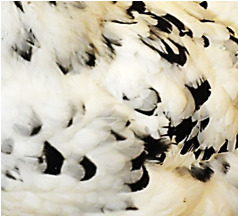|
We are pleased to announce that The American Erminette by Curt Burroughs is now published and available for sale!
|
Click the link below to purchase!
|
Erminettes are found in three color phases; White Erminette - Erminette - Black Erminette. The word 'Erminette' refers to both the breed and the color. Historically this often caused confusion and still does today at times. As we learn about the Erminette breed from a genetic standpoint, we will be focusing our attention on the three color phases. All three of the color phases are natural hallmarks of the Erminette breed. However, while the White Erminettes and Black Erminettes are invaluable in the breeding pen and productive powerhouses in the coop, they have little to no use outside of the breeding pen or coop. For example; White Erminettes and Black Erminettes should never be shown in the showring. And while these two expressions are productive examples of the breed, they lack the vibrant coloration of the Erminette color for which this breed is known.
Erminette color genetics are governed by two sets of genetic expressions.
1) Dominant white
2) Modifiers which allow black to leak through
Let's start with dominant white as this is the easiest to understand and put into practice. If we start with a bird that has no genes for dominant white the bird will be solid black (Black Erminette). If we add one dominant white gene to this black bird we will end up with a bird that is Erminette colored (Erminette). If we were to add two dominant white genes to the black bird then we end up with a bird that is solid white (White Erminette).
Make Note: Crossing white breeds of chickens to black breeds of chickens almost never produces the beautiful Erminette color of the Erminette breed. One known exception to this is when White Leghorns are crossed with Black Australorps. These are known as California Whites and they will be mostly white with a few random black streaks.
BELOW YOU WILL FIND HOW TO BREED TO GET THE DESIRED COLOR
``````````````````````````````````````````````````````````````````````````````````````````````````````````````````````````````````````````````````````````````````````````````````````````````````````````````````````````````````````````````
ERMINETTE X ERMINETTE 25% WHITE 50% ERMINETTE 25% BLACK
``````````````````````````````````````````````````````````````````````````````````````````````````````````````````````````````````````````````````````````````````````````````````````````````````````````````````````````````````````````````
ERMINETTE X WHITE 50% WHITE 50% ERMINETTE
``````````````````````````````````````````````````````````````````````````````````````````````````````````````````````````````````````````````````````````````````````````````````````````````````````````````````````````````````````````````
ERMINETTE X BLACK 50% ERMINETTE 50% BLACK
``````````````````````````````````````````````````````````````````````````````````````````````````````````````````````````````````````````````````````````````````````````````````````````````````````````````````````````````````````````````
WHITE X BLACK 100% ERMINETTE
``````````````````````````````````````````````````````````````````````````````````````````````````````````````````````````````````````````````````````````````````````````````````````````````````````````````````````````````````````````````
WHITE X WHITE 100% WHITE
``````````````````````````````````````````````````````````````````````````````````````````````````````````````````````````````````````````````````````````````````````````````````````````````````````````````````````````````````````````````
BLACK X BLACK 100% BLACK
``````````````````````````````````````````````````````````````````````````````````````````````````````````````````````````````````````````````````````````````````````````````````````````````````````````````````````````````````````````````
Now, the modifying genes which allow the black to leak through on the Erminette colored birds is more difficult to truly pinpoint. As a result they are more difficult to predict and 'lock in' so to speak. These rather unknown modifiers effect two color outcomes on the Erminette colored bird (we are not talking the White Erminette or Black Erminette birds regarding the modifiers. These color phases still carry the modifiers, however you cannot see them as they are not visibly expressed on solid white or solid black birds). The two color outcomes are as follows-
1) The amount of black feathers present
2) If the black feathers will be solid black and the white feathers solid white
A good colored Erminette should be made up of 85% white and 15% black (the black being dispersed evenly throughout the entire body). The amount of feathers that will be black in the Erminette bird are dependent on the modifiers and how much they either limit or expand the black on the bird. Were as color genes and pattern genes are generally steady and very predictable, modifiers are very fluid and generally unpredictable in how they will express themselves. That is why it is advisable to breed two Erminette colored birds which have the appropriate white to black ration together as your odds of producing chicks with the proper ratio will be higher. While it is possible to develop a strain that is consistent in producing stock with the proper color balance, there will always be individuals who will have too many black feathers or not enough black feathers.
A good colored Erminette should have feathers which are either solid white or solid black. Black feathers with white markings or white feathers with streaks of black are to be avoided on the individual feather. These issues are the result of the modifiers and how well they allow for the desired expression (again, this issue will not effect the solid white or solid black birds; only the Erminette colored).
1) The amount of black feathers present
2) If the black feathers will be solid black and the white feathers solid white
A good colored Erminette should be made up of 85% white and 15% black (the black being dispersed evenly throughout the entire body). The amount of feathers that will be black in the Erminette bird are dependent on the modifiers and how much they either limit or expand the black on the bird. Were as color genes and pattern genes are generally steady and very predictable, modifiers are very fluid and generally unpredictable in how they will express themselves. That is why it is advisable to breed two Erminette colored birds which have the appropriate white to black ration together as your odds of producing chicks with the proper ratio will be higher. While it is possible to develop a strain that is consistent in producing stock with the proper color balance, there will always be individuals who will have too many black feathers or not enough black feathers.
A good colored Erminette should have feathers which are either solid white or solid black. Black feathers with white markings or white feathers with streaks of black are to be avoided on the individual feather. These issues are the result of the modifiers and how well they allow for the desired expression (again, this issue will not effect the solid white or solid black birds; only the Erminette colored).







